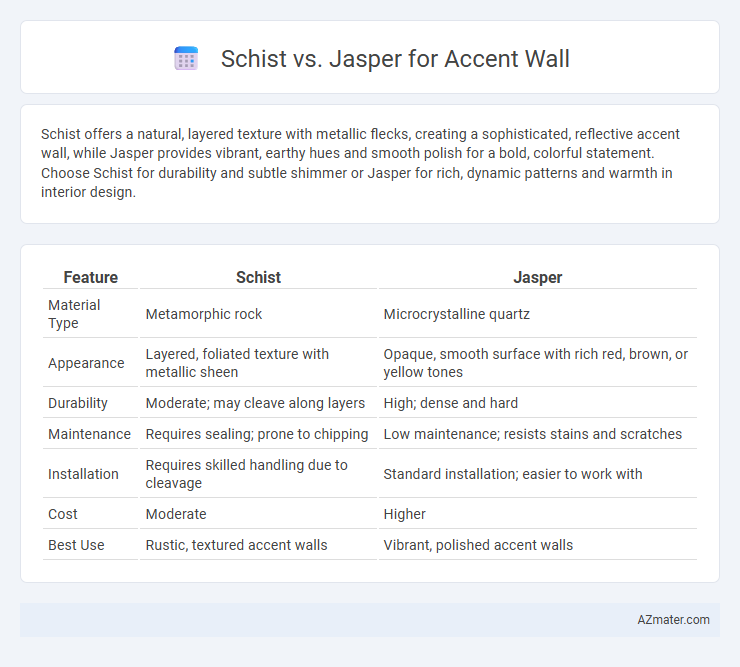Schist offers a natural, layered texture with metallic flecks, creating a sophisticated, reflective accent wall, while Jasper provides vibrant, earthy hues and smooth polish for a bold, colorful statement. Choose Schist for durability and subtle shimmer or Jasper for rich, dynamic patterns and warmth in interior design.
Table of Comparison
| Feature | Schist | Jasper |
|---|---|---|
| Material Type | Metamorphic rock | Microcrystalline quartz |
| Appearance | Layered, foliated texture with metallic sheen | Opaque, smooth surface with rich red, brown, or yellow tones |
| Durability | Moderate; may cleave along layers | High; dense and hard |
| Maintenance | Requires sealing; prone to chipping | Low maintenance; resists stains and scratches |
| Installation | Requires skilled handling due to cleavage | Standard installation; easier to work with |
| Cost | Moderate | Higher |
| Best Use | Rustic, textured accent walls | Vibrant, polished accent walls |
Introduction to Schist and Jasper as Accent Wall Materials
Schist, a metamorphic rock characterized by its flaky texture and shimmering mica content, offers a natural, rugged aesthetic ideal for accent walls in modern and rustic interiors. Jasper, a form of opaque, impure quartz, is prized for its vibrant colors and smooth surface, providing a bold, artistic statement when used as an accent wall material. Both Schist and Jasper bring unique textures and visual appeal, enhancing architectural designs with their distinctive mineral compositions and color variations.
Geological Origins of Schist and Jasper
Schist forms through regional metamorphism, where sedimentary or igneous rocks undergo intense heat and pressure, resulting in its foliated, layered texture rich in mica and quartz. Jasper is a microcrystalline variety of chalcedony, created from silica-rich sediment or volcanic ash that is compacted and mineralized over time, exhibiting a smooth, opaque surface in vibrant colors. These distinct geological origins influence their durability, texture, and aesthetic appeal, making schist ideal for rustic, textured accent walls and jasper suited for polished, colorful feature surfaces.
Visual Characteristics: Schist vs Jasper
Schist features a layered, flaky texture with a metallic sheen that reflects light, giving accent walls a dynamic, natural appearance. Jasper displays a smooth, opaque surface with rich, variable colors ranging from deep reds to earthy browns, creating a bold and consistent visual impact. Choosing between schist and jasper for an accent wall depends on whether a textured, shimmering effect or a solid, colorful statement is desired.
Color Variations and Patterns
Schist offers a dynamic range of earthy tones including grays, browns, and subtle greens, characterized by its layered, flaky texture that creates natural linear patterns ideal for rustic or contemporary accent walls. Jasper, known for its vibrant and diverse color palette spanning reds, yellows, greens, and browns, features smooth, opaque surfaces with intricate swirling or spotted patterns that add bold visual interest and depth. Choosing between schist and jasper for an accent wall depends on the desired aesthetic, with schist emphasizing textured, natural striations and jasper providing rich, polished stone artistry.
Durability and Maintenance Requirements
Schist offers high durability with its natural layered structure, resisting wear and scratches effectively, making it ideal for accent walls requiring long-lasting materials. Jasper, known for its dense and hard composition, provides excellent durability but may demand more maintenance to preserve its polished finish and color vibrancy. Both stones resist staining and moisture, yet schist generally requires less frequent sealing compared to jasper, optimizing upkeep over time.
Installation Considerations for Schist and Jasper
Schist offers a natural layered texture that requires careful handling during installation to prevent flaking and ensure secure adhesion, often benefiting from professional cutting tools and appropriate sealants. Jasper, known for its dense, smooth structure, allows for easier cutting and installation with standard stone tools, providing a durable surface that resists chipping and is low maintenance. Both materials demand a sturdy backing and precise alignment to achieve a flawless accent wall, but Schist's foliated composition demands extra attention to surface preparation and moisture control.
Cost Comparison: Schist vs Jasper
Schist offers a cost-effective option for accent walls, typically priced between $3 to $7 per square foot, making it ideal for budget-conscious projects. Jasper, known for its vibrant patterns and durability, generally costs more, ranging from $8 to $15 per square foot, reflecting its premium status. The choice between Schist and Jasper heavily depends on budget considerations, with Schist providing affordability without compromising natural stone aesthetics.
Design Styles Suited for Schist or Jasper Accent Walls
Schist accent walls suit rustic, industrial, and modern farmhouse designs due to their natural texture and shimmering layers, enhancing spaces with earthy tones and rugged sophistication. Jasper, with its vibrant colors and smooth surface, complements eclectic, bohemian, and contemporary interiors, adding bold visual interest and artistic flair. Both materials provide distinct aesthetic qualities that elevate accent walls according to the desired interior design theme.
Environmental Impact and Sustainability
Schist, a natural metamorphic rock, offers high durability with minimal environmental impact due to its abundant availability and low-energy extraction processes. Jasper, a form of microcrystalline quartz, is valued for its vibrant colors but often requires more intensive mining techniques, potentially increasing ecological disturbance and carbon footprint. Choosing schist for accent walls supports sustainability through longer lifespan and reduced habitat disruption compared to the more extraction-intensive jasper.
Choosing the Right Stone for Your Accent Wall
Schist offers a textured, layered appearance with natural glittery mica flakes, creating a dynamic and rustic accent wall ideal for adding depth and warmth. Jasper, known for its smooth, dense composition and rich, earthy colors like red, brown, or yellow, provides a polished, vibrant look that stands out as a bold design statement. When choosing between schist and jasper, consider the desired aesthetic, maintenance level, and the specific environment, as schist suits natural, rugged themes while jasper complements contemporary, colorful interiors.

Infographic: Schist vs Jasper for Accent Wall
 azmater.com
azmater.com